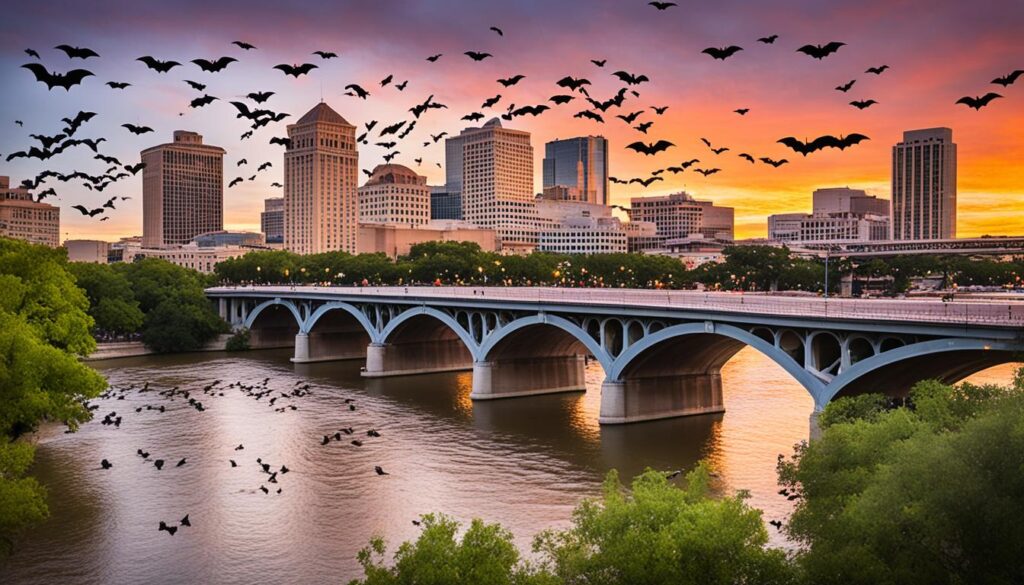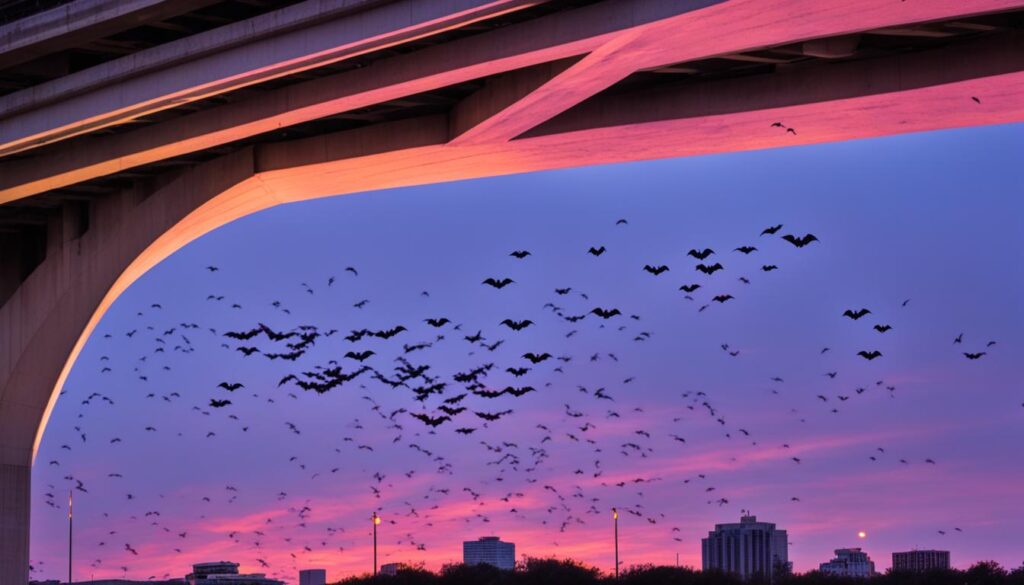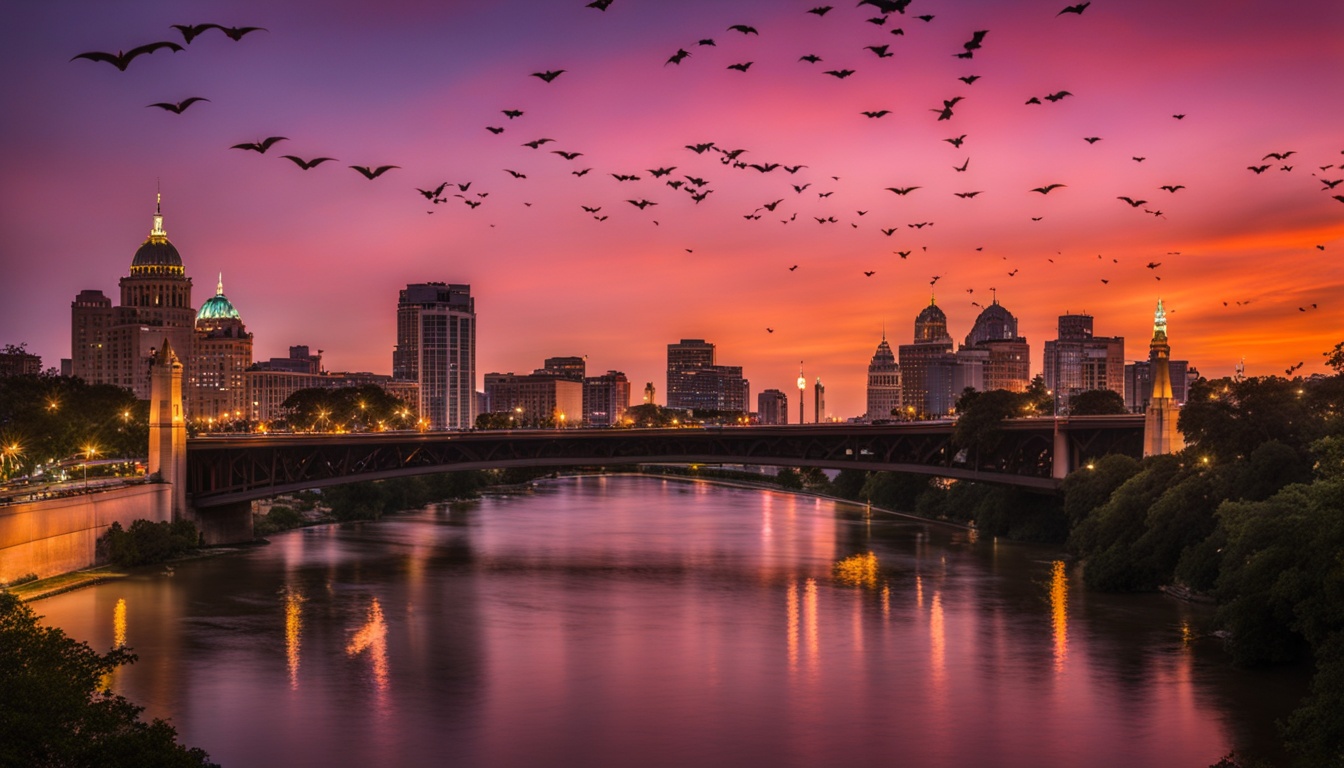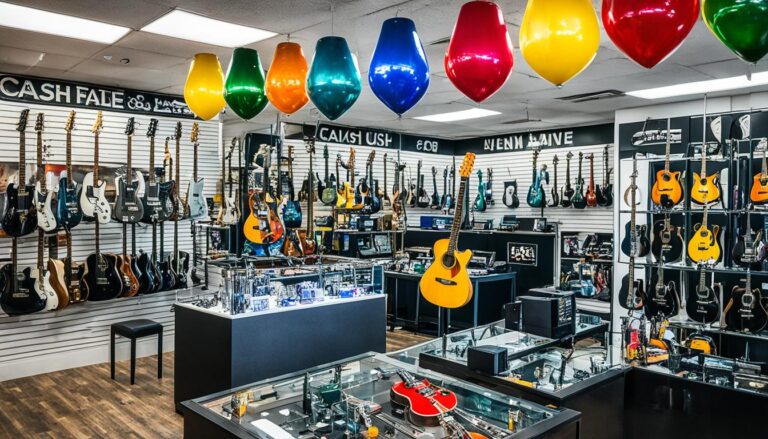Congress Avenue Bridge: Bats and Views
Did you know that Austin has the most bats in a city in North America? Around 1.5 million Mexican Free-Tailed Bats live under the Congress Avenue Bridge. They fly out from late March to early fall. These bats eat between 10,000 and 30,000 pounds of bugs each night. The story of these bats began after a 1980 bridge renovation. It accidentally made a perfect home for them.
This design offers ideal spots for the bats to rest. Nearly all these bats are female. They each have one baby bat in early June. After five weeks, the baby bats can fly and catch insects by themselves. This event attracts locals and visitors every night. They come to see this amazing sight against Austin’s skyline.
The Congress Avenue Bridge is famous for watching bats. As they fly out, they form a breathtaking scene above downtown Austin. It’s a mix of natural beauty and city landscape.
Key Takeaways
- The Ann W. Richards Congress Avenue Bridge is home to North America’s largest urban bat colony.
- Each night from late March to early fall, up to 1.5 million bats consume 10,000 to 30,000 pounds of insects.
- Almost all resident bats are female, giving birth to their pups in early June.
- The bats’ nightly emergence creates one of the most remarkable urban bat-viewing experiences globally.
- Austin celebrates its unofficial bat mascots with Bat Fest every mid-August on the Congress Avenue Bridge.
Introduction to the Congress Avenue Bridge
The Congress Avenue Bridge stands at the center of Austin. It’s known for its rich history and cultural value. People love it for its views of the Austin skyline.
The History of the Babylon
The bridge was first built as a wooden toll bridge in 1875, costing $100,000. It officially opened on April 4th, 1910. Since then, it’s changed a lot, showing Austin’s growth and care for history.
Renovation and Bat Habitat
In the 1980s, the Congress Avenue Bridge was renovated. This work made it a home for bats. Now, it houses 1.5 million Mexican Free-Tailed Bats each summer.
This has made the bridge a top spot for visitors. They come to see the bats and enjoy the views. It’s a unique way to experience nature in the city.
The Mexican Free-Tailed Bats of Austin
The Mexican Free-Tailed Bats are an important part of Austin’s environment. Each year, they travel from central Mexico to the southwestern U.S. Their movement to Austin is especially significant.

Migration Patterns
In late spring, these bats arrive in Austin. They live under the Ann W. Richards Congress Avenue Bridge. This migration brings about 1.5 million bats, making it North America’s biggest urban bat colony.
Mostly female bats come, having one baby each in early June.
Daily Flight Routine
From late March to early fall, they put on a nightly show. They fly out from under the bridge from 7:30 to 9:45 p.m. Their exit can last up to 45 minutes.
By summer’s end, about 1.5 million bats fly out to eat insects. They eat between 10,000 and 30,000 pounds of bugs each night, helping control pests.
Ecological Importance
Bats play a big role in keeping nature in balance in Austin. They eat lots of insects, which helps control mosquitoes and farm pests. This helps with pest management.
They also bring around 100,000 tourists each year. This shows the community’s efforts to protect these bats.
Best Times to Visit for Bat Watching
The best season to watch bats at Congress Avenue Bridge is from late March to early fall. This is when North America’s biggest urban bat colony lives in Austin. They treat onlookers to a stunning display as they leave the bridge to feed each evening.
Seasonal Variations
Different times of the year offer varied bat watching experiences. From March to September, bats leave their bridge home from 7:30 to 9:45 p.m. for their insect meals. Their nightly flights, eating up to 30,000 pounds of insects, are a sight to behold and help the environment too.

Optimal Viewing Conditions
The best bat watching happens at sunset. Getting there by 7:00 p.m. lets you see the entire 45-minute emergence. The weather also affects when bats come out. For example, they fly out later in colder temperatures or if it’s raining. The Austin Bat Fest in mid-August offers great views, music, food, and a bat costume contest.
Key Statistics:
- Flight typically occurs between 7:30-9:45 p.m.
- Up to 1.5 million bats take to the summer sky by season’s end.
- Flights can go on for 45 minutes because of the large bat numbers.
- Best watching conditions are when it’s above 50°F without rain.
Knowing about these seasonal changes and best conditions will make your bat-watching adventure memorable. It’s a chance to see Austin’s night-flying stars in action.
Top Viewing Spots for Bat Sightings
Austin is famous for its bats. There are many great places to watch them. Whether on land or water, you’ll find perfect spots to see the bats at night.

Statesman Bat Observation Center
The Statesman Bat Observation Center has a grassy spot for watching bats. It’s near Congress Avenue Bridge. From here, you can see about 1.5 million bats fly out. This amazing sight can last up to 45 minutes against the evening sky.
Butler Hike & Bike Trail
The Butler Hike & Bike Trail is another great spot. It goes around Lady Bird Lake and has many places to see the bats. With the city in the background, you can find the perfect spot to watch.
On the Water: Kayaks and Paddleboards
Renting kayaks and paddleboards gives a special view. You can paddle under the bridge and look up to see millions of bats. The night sky and city lights reflect on the water, making it magical. You can rent gear from many places around the lake.
Ann W. Richards Congress Avenue Bridge
The Ann W. Richards Congress Avenue Bridge is a standout in Austin for blending history with today. It opened on April 4, 1910. The bridge is 945.9 feet long and 60 feet wide, spanning Lady Bird Lake.
It honors former Texas Governor Ann W. Richards. The bridge shows Austin’s effort to grow while respecting nature.
The bridge is world-famous not just for its design but also as the home to the largest urban bat colony in North America. Between 750,000 and 1.5 million Mexican free-tailed bats make it their home in summer. Their dusk flights draw 100,000 tourists each year, showcasing Austin’s ecological commitment.

A 1999 study found the bats bring Austin $7.9 million annually. The bridge is crucial for both transport and as a cultural and environmental landmark. The “Bats and Bridges” project with Bat Conservation International highlights this commitment.
The bats even inspired the Austin Ice Bats hockey team name. This shows how nature and city life mix in Austin. The Ann W. Richards Congress Avenue Bridge truly stands as an iconic Austin landmark.
| Feature | Details |
|---|---|
| Opening Date | April 4, 1910 |
| Length | 945.9 feet (288.3 m) |
| Width | 60 feet (18 m) |
| Bat Population | 750,000 to 1.5 million |
| Annual Tourist Attraction | 100,000 |
| Economic Impact | $7.9 million per year |
Educational Bat Tours and Excursions
The Ann W. Richards Congress Avenue Bridge is famous for its large bat colony. It provides a stunning nightly spectacle. But Austin offers much more for those willing to dive deeper. There are many bat tours and excursions that teach about these fascinating creatures. They highlight how Mexican free-tailed bats eat around 30,000 pounds of insects each night. This helps both our environment and farming.
Educational trips near Congress Avenue Bridge make visits more interesting. They mix sightseeing with insights from experts. These tours cover the bats’ entire evening routine. This starts about 15-30 minutes before sunset and includes their insect hunting. You can choose from different types of tours. For example, riverboat cruises add a view from the water and include educational chats. These tours give a full picture of why bats matter. They mix fun with learning.
Every year in mid-August, Austin celebrates Bat Fest. It highlights bat importance and focuses on conservation. With more than 50 stalls, Bat Fest is both fun and enlightening. It works well with the educational tours to give a full bridge experience. It encourages both locals and visitors to value and protect Austin’s bats.
These bat tours and excursions are not just fun. They deepen the appreciation for the Congress Avenue Bridge and conservation work. People leave with great memories and respect for the bats’ crucial role in nature.







